allies
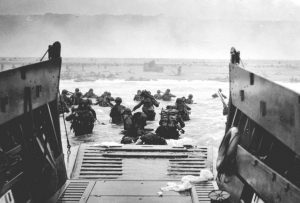 Most people from the Baby Boomer Generation know the significance of D-Day, but it occurs to me that many people in the younger generations may not really know what it was all about. Operation Overlord was the Allied invasion of northern France, commonly known as D-Day. The operation was under the direction of Supreme Allied Commander General Dwight D. Eisenhower. The operation had a brief 3 day window in which to take place, and June 5th had been chosen to be the day, but the day dawned gloomy, so the operation had to be scrubbed for the day.
Most people from the Baby Boomer Generation know the significance of D-Day, but it occurs to me that many people in the younger generations may not really know what it was all about. Operation Overlord was the Allied invasion of northern France, commonly known as D-Day. The operation was under the direction of Supreme Allied Commander General Dwight D. Eisenhower. The operation had a brief 3 day window in which to take place, and June 5th had been chosen to be the day, but the day dawned gloomy, so the operation had to be scrubbed for the day.
Then on June 6th, the orders came down that Operation Overlord was a go. By daybreak, 18,000 British and American parachutists were already on the ground. An additional 13,000 aircraft were mobilized to provide air cover and support for the invasion, among them the B-17, Raggedy Ann, which was carrying my dad, Allen Spencer, who was a Top Turret Gunner and Flight Engineer. At 6:30 am, American troops came ashore at Utah and Omaha beaches. The British and Canadians overcame light opposition to capture Gold, Juno and Sword beaches, as did the Americans at Utah. Omaha beach was a much different situation, however, where the US First Division battled high seas, mist, mines, burning vehicles, and German coastal batteries, including an elite infantry division, which spewed heavy fire. Many wounded Americans ultimately drowned in the high tide. British divisions, which landed at Gold, Juno, and Sword beaches, and Canadian troops also met with heavy German fire.

The troops persevered, even though the loses were great, and in the end the operation was declared a victory. There were many reasons that D-Day was successful, even against all odds. The Allies had fooled the Germans, who thought the attack was going to occur farther along the coast at Calais because this was the shortest route by sea, even when the attack began on the beaches Hitler was still convinced the attack was going to occur at Calais. What a shock that must have been when he found out that the attack took place on the beaches of Normandy. False intelligence spread by the allies spread false information to the Germans, and they bought it.
There were many factors that all worked together to make the plan work. Wooden guns on the South Coast of England, wooden planes, dropped plastic dummies out of planes, they put mirrors up on their ships and the Germans were fooled as they saw themselves going the other way. New technology specifically designed for the landing enabled the Allies to gain an advantage over the Germans. Mulberries, the floating docks the Allies used to land, enabled the Allies to land safely and disembark while firing. Some of the beaches were practically empty, however, on Omaha beach the Allies suffered heavy losses numbering 2000 in total. Operation Overlord had been planned for many years and so they were ready. The Germans had to keep control of the other parts of their empires, so their troops were elsewhere. Hitler denied that his forces were losing in Normandy, and  would not authorize the mobilization of forces stationed near Normandy.
would not authorize the mobilization of forces stationed near Normandy.
As for the Allies, the troops involved were highly trained, equipped and motivated. Their battle plan was well prepared. All the necessary manpower and logistics were available to them. The air space was controlled by the Allies. The sea lanes were very short and the seas were in Allied hands. The deception plan was flawless. The Germans had no idea what was coming. The French Resistance was highly effective. The German troop who were there were poorly motivated. Hitler’s Defense Planning was completely flawed. But, the biggest victory is that the troops did their job.
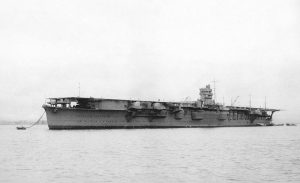 The Japanese had a tendency to be sneaky about their weapons of warfare, and their attack plans, as we know from Pearl Harbor. One such well kept secret was the Hiryu…which means Flying Dragon. The ship was a modified Soryu design that was built exclusively for the Imperial Japanese Navy. The Soryu, which means Blue Dragon, was built first, and because of the heavy modifications, the Hiryu was almost considered to be a separate class of ship. Hiryu had a displacement of 17,600 tons, length of 746 feet 1 inch, beam of 73 feet 2 inches, draft of 25 feet 7 inches and a speed of 34 knots. Built in 1931, “these two ships became prototypes for almost all subsequent Japanese carriers. They had continuous flight deck, two-level hangar, small island superstructure, two deflexed down and aft funnels and three elevators. As a whole ship design (within the limits of displacement assigned on it) has appeared rather successful, harmoniously combining high speed with strong AA armament and impressive number of air group.” The Hiryu, unlike the small height hangar levels of the Soryu, was built to an advanced design. “Her freeboard height was increased by one deck, island was transferred to a port side (Hiryu became second after Akagi and last Japanese carrier with an island on a port side). Breadth of a flight deck was increased on 1m, a fuel stowage on 20%. She had a little strengthened protection: belt thickness abreast machinery raised to 48mm.”
The Japanese had a tendency to be sneaky about their weapons of warfare, and their attack plans, as we know from Pearl Harbor. One such well kept secret was the Hiryu…which means Flying Dragon. The ship was a modified Soryu design that was built exclusively for the Imperial Japanese Navy. The Soryu, which means Blue Dragon, was built first, and because of the heavy modifications, the Hiryu was almost considered to be a separate class of ship. Hiryu had a displacement of 17,600 tons, length of 746 feet 1 inch, beam of 73 feet 2 inches, draft of 25 feet 7 inches and a speed of 34 knots. Built in 1931, “these two ships became prototypes for almost all subsequent Japanese carriers. They had continuous flight deck, two-level hangar, small island superstructure, two deflexed down and aft funnels and three elevators. As a whole ship design (within the limits of displacement assigned on it) has appeared rather successful, harmoniously combining high speed with strong AA armament and impressive number of air group.” The Hiryu, unlike the small height hangar levels of the Soryu, was built to an advanced design. “Her freeboard height was increased by one deck, island was transferred to a port side (Hiryu became second after Akagi and last Japanese carrier with an island on a port side). Breadth of a flight deck was increased on 1m, a fuel stowage on 20%. She had a little strengthened protection: belt thickness abreast machinery raised to 48mm.”
Hiryu took part in Japanese invasion of French Indochina (Now Vietnam, Cambodia and Laos) in mid 1940s, the attack on Pearl Harbor and the Battle of Wake Island. The ship became a great enemy of the Allies. Then, along with three other fleet carriers, Hiryu participated in the Battle of Midway Atoll in North Pacific Ocean in June 1942. Initially, the Japanese forces managed to bombard US forces on the atoll. It didn’t look good for the 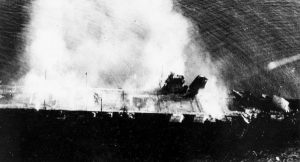 Allies, but on June 4, 1942, the Japanese aircraft carriers were attacked by dive-bomber aircraft from USS Enterprise, USS Yorktown, USS Hornet, and Midway Atoll. Hiryu was hit and severely crippled, and was set on fire. Japanese destroyer Makigumo torpedoed Hiryu on June 5, 1942 at 05:10 am, because she could not be salvaged. Only 39 men survived as after 4 hours, she sank with bodies of 389 men. Three other Japanese carriers were also sunk during the Battle of Midway. It was a battle that brought Japan’s first naval defeat since the Battle of Shimonoseki Straits in 1863. It was a great day for the Allies.
Allies, but on June 4, 1942, the Japanese aircraft carriers were attacked by dive-bomber aircraft from USS Enterprise, USS Yorktown, USS Hornet, and Midway Atoll. Hiryu was hit and severely crippled, and was set on fire. Japanese destroyer Makigumo torpedoed Hiryu on June 5, 1942 at 05:10 am, because she could not be salvaged. Only 39 men survived as after 4 hours, she sank with bodies of 389 men. Three other Japanese carriers were also sunk during the Battle of Midway. It was a battle that brought Japan’s first naval defeat since the Battle of Shimonoseki Straits in 1863. It was a great day for the Allies.
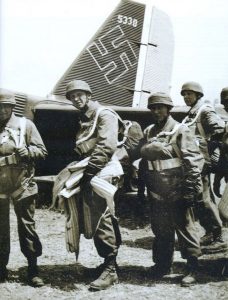 Every new for of weapon or battle plan must have a first time of use. I don’t know if the soldiers or the inventors would be more nervous as this plan unfolded, but my guess is the soldiers, who must place their lives in the hands of the inventor, and pray that he knew what he was doing. The Battle of Crete, also known as Operation Mercury was fought during World War II on May 20, 1941 to May 21, 1941. It was short-lived mostly because of the “firsts” the Allies saw during this battle.
Every new for of weapon or battle plan must have a first time of use. I don’t know if the soldiers or the inventors would be more nervous as this plan unfolded, but my guess is the soldiers, who must place their lives in the hands of the inventor, and pray that he knew what he was doing. The Battle of Crete, also known as Operation Mercury was fought during World War II on May 20, 1941 to May 21, 1941. It was short-lived mostly because of the “firsts” the Allies saw during this battle.
On that day, May 20, 1941, the Nazis began an airborne invasion of the island of Crete. Greek forced were joined by other Allied troops to defend the island. After one day of fighting, the Germans appeared to be losing, as they had suffered heavy casualties. This gave the Allies a feeling of confidence in their victory over the Nazis. Unfortunately that feeling of confidence was a little premature. The next day, the Allies encountered some communication failures, and due to the Allied tactical hesitation, as 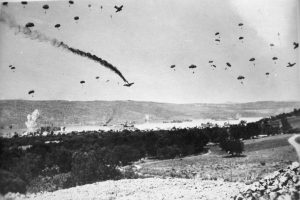 well as German offensive operations, Maleme Airfield in western Crete fell to the Germans. This enabled the Germans to land reinforcements and overwhelm the defensive positions on the north side of the island. The Allied forces had no choice but to withdrew to the south coast. More than half of them were evacuated by the British Royal Navy, but the remainder surrendered or joined the Cretan resistance. The defense of Crete evolved into a costly naval engagement, and by the end of the campaign the Royal Navy’s eastern Mediterranean strength had been reduced to only two battleships and three cruisers…not enough to defend anything.
well as German offensive operations, Maleme Airfield in western Crete fell to the Germans. This enabled the Germans to land reinforcements and overwhelm the defensive positions on the north side of the island. The Allied forces had no choice but to withdrew to the south coast. More than half of them were evacuated by the British Royal Navy, but the remainder surrendered or joined the Cretan resistance. The defense of Crete evolved into a costly naval engagement, and by the end of the campaign the Royal Navy’s eastern Mediterranean strength had been reduced to only two battleships and three cruisers…not enough to defend anything.
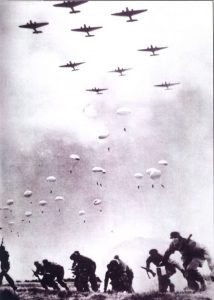
So…what made this an operation of firsts? The Battle of Crete was the first time that German paratroops, known as Fallschirmjäger, were used en masse. It was also the first mainly airborne invasion in military history, and the first time the Allies made significant use of intelligence from decrypted German messages from the Enigma machine. It was also the first time German troops encountered mass resistance from a civilian population. Prior to this time the Nazis held enough power over the civilians to force them to comply. These people fought back…for the first time. Due to the number of casualties and the belief that airborne forces no longer had the advantage of surprise, Adolf Hitler became reluctant to authorize further large airborne operations, preferring instead to employ paratroopers as ground troops. In contrast, the Allies were impressed by the potential of paratroopers and started to form airborne-assault and airfield-defense regiments of their own. Major changes in military history, brought about by one battle.
 Almost immediately after he gained power in Germany, Adolf Hitler began making plans to control the world. He never was and never would be happy with just being the dictator of Germany. By May of 1940, Hitler had a plan in place to seize control. On 10 May 1940, Germany invaded Luxembourg, the Netherlands, and Belgium under the operational plan Fall Gelb, or Case Yellow. The Battle of Belgium or Belgian Campaign, often referred to within Belgium as the 18 Days’ Campaign. The Allied armies tried to halt the German Army in Belgium, thinking it to be the main German thrust. After the French had fully committed the best of the Allied armies to Belgium between 10 and 12 May, the Germans enacted the second phase of their operation. It was an unexpected move, and since the Allies were unprepared, the Germans advanced toward the English Channel. The German Army reached the Channel after five days, encircling the Allied armies. The Germans gradually reduced the pocket of Allied forces, forcing them
Almost immediately after he gained power in Germany, Adolf Hitler began making plans to control the world. He never was and never would be happy with just being the dictator of Germany. By May of 1940, Hitler had a plan in place to seize control. On 10 May 1940, Germany invaded Luxembourg, the Netherlands, and Belgium under the operational plan Fall Gelb, or Case Yellow. The Battle of Belgium or Belgian Campaign, often referred to within Belgium as the 18 Days’ Campaign. The Allied armies tried to halt the German Army in Belgium, thinking it to be the main German thrust. After the French had fully committed the best of the Allied armies to Belgium between 10 and 12 May, the Germans enacted the second phase of their operation. It was an unexpected move, and since the Allies were unprepared, the Germans advanced toward the English Channel. The German Army reached the Channel after five days, encircling the Allied armies. The Germans gradually reduced the pocket of Allied forces, forcing them  back to the sea. The Belgian Army surrendered on 28 May 1940, ending the Battle of Belgium.
back to the sea. The Belgian Army surrendered on 28 May 1940, ending the Battle of Belgium.
The first tank battle of the war occurred during the Battle of Belgium. It was called the Battle of Hannut. It was the largest tank battle in history at the time, but was later surpassed by the battles of the North African Campaign and the Eastern Front. The battle also included the Battle of Fort Eben-Emael, the first strategic airborne operation using paratroopers ever attempted. It would seem that there were a lot of firsts that happened during the 18 days of the Battle of Belgium.
Strangely, the official German historic account stated that in the 18 days of bitter fighting, the Belgian Army 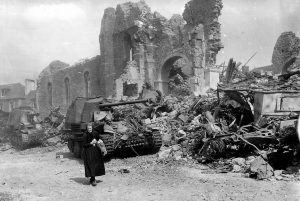 were tough opponents and spoke of the “extraordinary bravery” of its soldiers. That surprises me, because the Germans hated to appear weaker than their opponents. Nevertheless, in the end, the Belgium forces were no match for the Germans, and the Belgian collapse forced the Allied withdrawal from continental Europe. The British Royal Navy were forced to evacuate Belgian ports during Operation Dynamo, allowing the British Expeditionary Force, along with many Belgian and French soldiers, to escape capture and continue military operations. France reached its own armistice with Germany in June 1940. Belgium continued to be occupied by the Germans until the autumn of 1944, when it was finally liberated by the Western Allies.
were tough opponents and spoke of the “extraordinary bravery” of its soldiers. That surprises me, because the Germans hated to appear weaker than their opponents. Nevertheless, in the end, the Belgium forces were no match for the Germans, and the Belgian collapse forced the Allied withdrawal from continental Europe. The British Royal Navy were forced to evacuate Belgian ports during Operation Dynamo, allowing the British Expeditionary Force, along with many Belgian and French soldiers, to escape capture and continue military operations. France reached its own armistice with Germany in June 1940. Belgium continued to be occupied by the Germans until the autumn of 1944, when it was finally liberated by the Western Allies.
 There was, during the Second World War, a somewhat strange and almost morbid plan that was concocted to dupe the Germans into believing that the Allies were going to invade Greece in 1943, when in fact, they were going to invade Sicily, some 500 miles away. The success of the mission really depended on the element of surprise, and in the end, the Allies needed something that would be believable to the Germans.
There was, during the Second World War, a somewhat strange and almost morbid plan that was concocted to dupe the Germans into believing that the Allies were going to invade Greece in 1943, when in fact, they were going to invade Sicily, some 500 miles away. The success of the mission really depended on the element of surprise, and in the end, the Allies needed something that would be believable to the Germans.
The thing that made the operation morbid was that in the end, they would use a dead body to bring about their deception. In their plan a body was dumped in the sea, to be discovered by Axis forces, carrying fake secret documents suggesting the invasion would be staged in Greece. They were a bit shocked when their plan worked, but work it did. The German troops were diverted to Greece, and Operation Mincemeat became a huge success, but even after it was over, it remained a source of secrecy, confusion, and conspiracy theory. The biggest source of confusion being…just who was this man who was found floating in the ocean, and how did he really die? For most people, the operation remains a mystery to this day, but one man believes that he now knows the true identity of the man found floating in the ocean.
In the 1956 film called “The Man Who Never Was,” one historian claims to have finally established beyond any reasonable doubt the identity of the person who played the part of the dead man, He believes he was a homeless Welshman named Glyndwr Michael. The body, which was given the identity of a fake Royal Marine, Major William Martin, was dropped into the sea off Spain in 1943. Winston Churchill had remarked that “Anyone but a bloody fool would know it was Sicily”, but after the tides carried Major Martin’s body into the clutches of Nazi agents, Hitler and his High Command became convinced Greece was the target. “You can forget about Sicily. We know it’s in Greece,” proclaimed General Alfred Jodl, head of the German supreme command operations staff.
“Mincemeat swallowed, rod, line and sinker” was the message sent to Churchill after the Allies learned the plot had worked. In recent years, there have been repeated claims that Mincemeat’s chief planner, Lieutenant Commander Ewen Montagu, was so intent on deceiving the Germans that he stole the body of a crew member from HMS Dasher, a Royal Navy aircraft carrier which exploded off the Scottish coast in March 1943, and lied to the dead man’s relatives. In 2003, a documentary based on 14 years of research by former police officer Colin 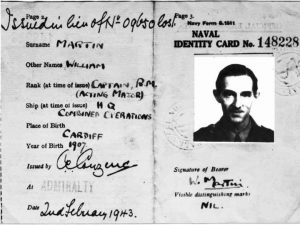 Gibbon claimed that ‘Major Martin’ was Dasher sailor Tom Martin. Then in 2004, official sanction appeared to be given to another candidate, Tom Martin’s crewmate John Melville. At a memorial service on board the current HMS Dasher, a Royal Navy patrol vessel, off the coast of Cyprus, Lieutenant Commander Mark Hill named Mr Melville as Major Martin, describing him as “a man who most certainly was”. Mr Melville’s daughter, Isobel Mackay, later told The Scotsman newspaper: “I feel very honored if my father saved 30,000 Allied lives.” I don’t suppose that we will ever know who the man really was, without exhuming his body, and that hardly seems right. Whoever he was, his family can rest assured that he saved many lives that day.
Gibbon claimed that ‘Major Martin’ was Dasher sailor Tom Martin. Then in 2004, official sanction appeared to be given to another candidate, Tom Martin’s crewmate John Melville. At a memorial service on board the current HMS Dasher, a Royal Navy patrol vessel, off the coast of Cyprus, Lieutenant Commander Mark Hill named Mr Melville as Major Martin, describing him as “a man who most certainly was”. Mr Melville’s daughter, Isobel Mackay, later told The Scotsman newspaper: “I feel very honored if my father saved 30,000 Allied lives.” I don’t suppose that we will ever know who the man really was, without exhuming his body, and that hardly seems right. Whoever he was, his family can rest assured that he saved many lives that day.
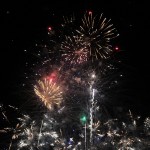 I think that one of the things most people look forward to in mid-summer is Independence Day. Of course, the normal holiday for many people is filled with picnics, fireworks, and celebration of our freedom. Many of us consider the price that was paid in the Revolutionary War to win our freedom from England, and then our thoughts move on to the many wars the United Stares has fought into keep our freedoms, and to win freedom for oppressed nations around the world. It’s a noble thing our soldiers do, often with little thanks from those they help. And all too often, their work is quickly forgotten or even protested by those who do not understand how important it is not to give away our freedoms to those who do not share our values.
I think that one of the things most people look forward to in mid-summer is Independence Day. Of course, the normal holiday for many people is filled with picnics, fireworks, and celebration of our freedom. Many of us consider the price that was paid in the Revolutionary War to win our freedom from England, and then our thoughts move on to the many wars the United Stares has fought into keep our freedoms, and to win freedom for oppressed nations around the world. It’s a noble thing our soldiers do, often with little thanks from those they help. And all too often, their work is quickly forgotten or even protested by those who do not understand how important it is not to give away our freedoms to those who do not share our values.
Whatever a person’s politics are, or even if they don’t participate at all, pretty much  everyone celebrates Independence Day. It is a beloved holiday in this country. It’s a day to celebrate who we are as a nation….the land of the free, and the home of the brave. The fireworks are to remember the rockets that were used in the battle for our independence. The patriot soldiers fought hard against the British, never giving up, even if they lost their lives in the battle. The danger was worth the risk. They could no longer be slaves to the British. They were being taxed without representation, and unmercifully. It was time for the United States to become it’s own nation. I don’t think the British have any inkling that they would lose the Revolutionary War. It was like being beaten by your child. How could that “kid” actually have grown enough to beat them…and yet, the “kid” had not only fought against the “parent” country, but they won. They fought and now we’re free!!
everyone celebrates Independence Day. It is a beloved holiday in this country. It’s a day to celebrate who we are as a nation….the land of the free, and the home of the brave. The fireworks are to remember the rockets that were used in the battle for our independence. The patriot soldiers fought hard against the British, never giving up, even if they lost their lives in the battle. The danger was worth the risk. They could no longer be slaves to the British. They were being taxed without representation, and unmercifully. It was time for the United States to become it’s own nation. I don’t think the British have any inkling that they would lose the Revolutionary War. It was like being beaten by your child. How could that “kid” actually have grown enough to beat them…and yet, the “kid” had not only fought against the “parent” country, but they won. They fought and now we’re free!!

Since they won, we have something wonderful to celebrate on July 4th…our independence. When I think of the alternative, I cringe. It’s not that I hate England, because, in fact, I don’t. I have relatives there, including in the royal family, so I don’t hate England, but we were just different. Our values and ideals were different. We could not peacefully co-exist the way we were, And yet, now that we are two separate nations, we are allies. We had to be equals in order to be allies. We had to have their respect, as a free nation, and we got it. We have been a respected, free nation since that day…July 4, 1776. And that is why we still celebrate our independence. Happy Independence Day everyone!!
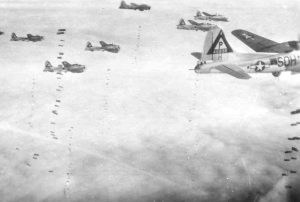 When a mistake is made in the air, it usually results in a disaster. Air disasters often involve the pilot, a mechanic, or an old part. Of course, some of the worst disasters were caused when an air traffic controller sent two planes to the same place at the same altitude. The resulting mid-air collision killed everyone on board. Mistakes are never good, but in the air they are especially devastating.
When a mistake is made in the air, it usually results in a disaster. Air disasters often involve the pilot, a mechanic, or an old part. Of course, some of the worst disasters were caused when an air traffic controller sent two planes to the same place at the same altitude. The resulting mid-air collision killed everyone on board. Mistakes are never good, but in the air they are especially devastating.
War is no different, in fact mistakes in war can be really disastrous. Gunners shooting at the enemy planes are often so focused that when the enemy flies past their own squadron, they can end up shooting down their own squadron members with friendly fire. 
The strange thing is that sometimes, a would be disaster ends up becoming one of the greatest miracles. Such was the case during World War II. The Americans planed a bombing run, and it was going to be a big bombing run. The orders had been issued. The problem…one squadron accidentally showed up thousands of feet lower down than the other one. In many cases, this would not have bee such a big problem, but both squadrons ended up a the drop site at the same time. The scheduled bombing began, and no one would really realize what was about to happen until it was too late.
Neither of the squadrons saw each other, until the bombs had been dropped. Miraculously, none of the lower planes were hit by the higher planes. It was a miracle of epic proportions. In addition, the Germans thought 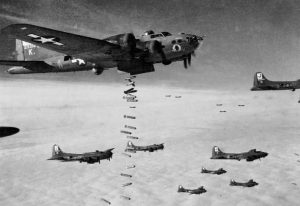 that the Allies had come up with an ingenious bombing strategy to bomb an area twice as much. After that bombing event, the Germans were scared that the Allies had this level of skill. It seemed completely impossible that they could plan a bomb run in which the lower planes flew in sync enough to allow the upper planes to drop their bombs in between the lower planes, while the lower planes were also dropping their bombs. It was impossible, and yet it happened. The impossible was achieved without one bit of planning. There is simply no other word for it. It was a miracle. God took a potential disaster and turned it into one of the greatest feats of warfare.
that the Allies had come up with an ingenious bombing strategy to bomb an area twice as much. After that bombing event, the Germans were scared that the Allies had this level of skill. It seemed completely impossible that they could plan a bomb run in which the lower planes flew in sync enough to allow the upper planes to drop their bombs in between the lower planes, while the lower planes were also dropping their bombs. It was impossible, and yet it happened. The impossible was achieved without one bit of planning. There is simply no other word for it. It was a miracle. God took a potential disaster and turned it into one of the greatest feats of warfare.
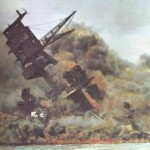
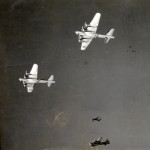 World War II had been raging since September 1, 1939. It was without doubt the most destructive war in history. Some say it was simply a continuation of World War I, that had ended in 1918. Others will blame the 1931 Japanese seizure of Manchuria from China, or Italy’s invasion and defeat of Ethiopia in 1935, or Adolf Hitler’s re-militarization of Germany in 1936, or the Spanish Civil War 1936 to 1939, or Germany’s occupation of Czechoslovakia in 1938 as possible beginnings. But, the two dates most often mentioned as “the beginning of World War II” are July 7, 1937, when the “Marco Polo Bridge Incident” led to war between Japan and China, and September 1, 1939, when Germany invaded Poland, which led Britain and France to declare war on Hitler’s Nazi state in retaliation. To me it would seem that the tensions that had begun before World War I, simply never went away. It would seem that there were many world leaders who were power hungry, and greedy for the lands that belonged to their neighbors. And when you look at the Middle East today, maybe not much has really changed.
World War II had been raging since September 1, 1939. It was without doubt the most destructive war in history. Some say it was simply a continuation of World War I, that had ended in 1918. Others will blame the 1931 Japanese seizure of Manchuria from China, or Italy’s invasion and defeat of Ethiopia in 1935, or Adolf Hitler’s re-militarization of Germany in 1936, or the Spanish Civil War 1936 to 1939, or Germany’s occupation of Czechoslovakia in 1938 as possible beginnings. But, the two dates most often mentioned as “the beginning of World War II” are July 7, 1937, when the “Marco Polo Bridge Incident” led to war between Japan and China, and September 1, 1939, when Germany invaded Poland, which led Britain and France to declare war on Hitler’s Nazi state in retaliation. To me it would seem that the tensions that had begun before World War I, simply never went away. It would seem that there were many world leaders who were power hungry, and greedy for the lands that belonged to their neighbors. And when you look at the Middle East today, maybe not much has really changed.
Wherever you place the beginning of World War II, you would agree that while the Japanese and the Germans may not have been war weary, the rest of the world really was. Before the Japanese attacked Pearl Harbor on December 7, 1941, the United States had somehow managed to stay out of the conflict. Whether that was right or wrong is a matter of opinion too. Nevertheless, when the Japanese brought the war to our front door, the United States answered with a vengeance. I’m sure the allies were glad to have the reinforcements, but also wondered why it had taken so long for us to get involved. Sometimes, I have wondered that myself, about that and other wars that we have come into just a little bit late in the game.
That said, we got into the war, and I believe that the extra military might that the United States brought to the Allied Forces was the tipping point in the war, because a war that had officially raged since September 1, 1939, was brought to an end on September 2, 1945, when Victory over Japan was celebrated in the United States. Japanese troops finally surrendered to Americans on the Caroline, Mariana, and Palau islands. Representatives of their emperor and prime minister were preparing to formalize their declaration of defeat. In Tokyo Bay, aboard the Navy battleship USS Missouri, Japanese foreign minister, Mamoru Shigemitsu and chief of staff of the Japanese army, Yoshijiro Umezu, signed the “instrument of surrender.” General Douglas MacArthur, commander of the US Army forces in the Pacific, and Admiral Chester Nimitz, commander of the US Pacific Fleet were there to represent the Allied victors.
After the surrender, Mamoru Shigemitsu was found guilty of war crimes. He was sentenced to seven years in prison. Oddly, it was he who had fought for concessions on the Japanese side in an attempt to secure an early peace. He was paroled in 1950 and went on to become chairman of Japan’s Progressive Party. General 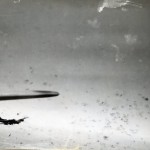
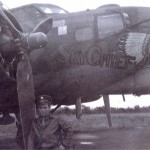 MacArthur would come up against him again when he was named commander in chief of the United Nations forces in Korea in 1950. For some people, it would seem, that one defeat simply isn’t enough, but that is another story. Today is VJ Day…Victory over Japan Day. It may not be a day that we remember as well as we do D Day, which simply stands for the day designated to storm the beaches at Normandy, or the attack on Pearl Harbor, but VJ Day is in reality as important a day as those others too, because it was the day that ended the world’s worst, and most destructive war.
MacArthur would come up against him again when he was named commander in chief of the United Nations forces in Korea in 1950. For some people, it would seem, that one defeat simply isn’t enough, but that is another story. Today is VJ Day…Victory over Japan Day. It may not be a day that we remember as well as we do D Day, which simply stands for the day designated to storm the beaches at Normandy, or the attack on Pearl Harbor, but VJ Day is in reality as important a day as those others too, because it was the day that ended the world’s worst, and most destructive war.
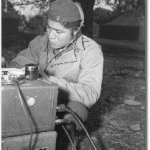 In a war, secrecy is vital. The different sides must take whatever steps necessary to inform their troops and allies of their next step, without revealing the plan to the enemy. In World War II, America and her allies were having trouble with the level of secrecy they were able to achieve. It seemed that no matter what code they used, it was broken almost immediately. It did not help matters that many of the Japanese cryptographers had been educated in the United States. They spoke very good English, and they were very amazingly adept at breaking top secret military codes. For America and her allies, coming up with newer and more complicated codes was becoming more and more difficult, and the Japanese cryptographers seemed to break the new codes almost as quickly as they were developed. They were in real trouble. Then someone remembered a type of code that had been used in World War I, and things began to look up a little for America and the allies. The code was the use of Code Talkers from the Choctaw tribe.
In a war, secrecy is vital. The different sides must take whatever steps necessary to inform their troops and allies of their next step, without revealing the plan to the enemy. In World War II, America and her allies were having trouble with the level of secrecy they were able to achieve. It seemed that no matter what code they used, it was broken almost immediately. It did not help matters that many of the Japanese cryptographers had been educated in the United States. They spoke very good English, and they were very amazingly adept at breaking top secret military codes. For America and her allies, coming up with newer and more complicated codes was becoming more and more difficult, and the Japanese cryptographers seemed to break the new codes almost as quickly as they were developed. They were in real trouble. Then someone remembered a type of code that had been used in World War I, and things began to look up a little for America and the allies. The code was the use of Code Talkers from the Choctaw tribe.
That someone was war analyst Philip Johnston. Phillip, an American who fought in World War I, stationed in France, was too old to fight in World War II, but he wanted to aid in the effort anyway. As a boy, he spent time 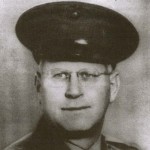 on the Navajo Indian Reservation, where his parents were Protestant missionaries. He learned to speak the Navajo language with his playmates. Suddenly, the idea of a secret military code based on the Navajo language made perfect sense to him.
on the Navajo Indian Reservation, where his parents were Protestant missionaries. He learned to speak the Navajo language with his playmates. Suddenly, the idea of a secret military code based on the Navajo language made perfect sense to him.
In mid-April of 1942, Marine recruiting personnel went to the Navajo Reservation, and presented their plan. They enlisted thirty volunteers from the agency schools at Fort Wingate and Shiprock, New Mexico and Fort Defiance, Arizona. It would be a tall order for these volunteers. Each one had to be fluent in Navajo and English, but they also had to be physically fit, because they would be messengers in a combat zone. They were told that they would be specialists in the United States as well as over seas. Some of them were underage, but birth records on the Reservation were not well kept, so it was easy for volunteers to lie about or just not know their true age, and so they could participate. Carl Gorman, a 36-year-old Navajo from Fort Defiance, was too old to be considered by the Marines, so he lied about his age in order to be accepted.
Because the Navajo language was complicated, and due to the many different dialects, the Japanese could 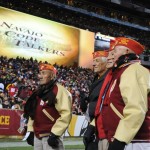 never crack the code. They even captured a Navajo soldier and made him listen to the talk for hours, but because he had not been trained, he was still unable to crack the code. By 1945, there were about 540 Navajos who served in the Marines, and of those 375 to 420 were trained as code talkers. The rest served in other capacities. The code talkers payed an instrumental part in the success of the war effort. On June 4, 2014, Chester Nez, the last living original code talker, passed away. Once, in an interview he said, “My first transmission—one that did not involve coordinates—was one I will always remember: Beh-na-ali-tsosie a-knah-as-donih ah-toh nish-na-jih-goh dah-di-kad ah-deel-tahi, which translates to: Enemy machine gun nest on your right flank. Destroy.” These were great men, and our nation owes them a debt it can never repay.
never crack the code. They even captured a Navajo soldier and made him listen to the talk for hours, but because he had not been trained, he was still unable to crack the code. By 1945, there were about 540 Navajos who served in the Marines, and of those 375 to 420 were trained as code talkers. The rest served in other capacities. The code talkers payed an instrumental part in the success of the war effort. On June 4, 2014, Chester Nez, the last living original code talker, passed away. Once, in an interview he said, “My first transmission—one that did not involve coordinates—was one I will always remember: Beh-na-ali-tsosie a-knah-as-donih ah-toh nish-na-jih-goh dah-di-kad ah-deel-tahi, which translates to: Enemy machine gun nest on your right flank. Destroy.” These were great men, and our nation owes them a debt it can never repay.

